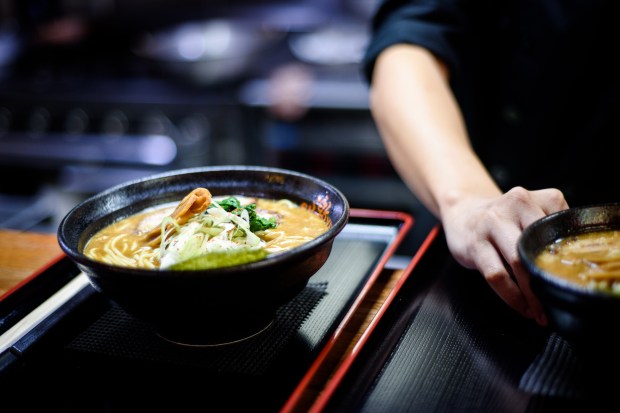How Wagamama’s Mobile Strategy Curries Favor With Customers

Mobile order-ahead is no longer a nice-to-have for QSRs – the tech, says Wagamama CIO Richard Tallboy, is now table stakes. In the latest Mobile Order-Ahead Tracker, Tallboy tells PYMNTS how mobile order-ahead is changing consumer behavior. Those shifts, he said, prompted the company to beef up its mobile app and think more strategically about the role payments could play in creating a better customer experience.
Now, more than ever, it’s in a QSR’s best interest to put digital on the menu and embrace mobile order-ahead technology. With consumers demanding fast mobile orders, and kitchens on the hook to ensure food comes out hot and fresh, it’s no surprise that the mobile order-ahead market is set to be worth $55 billion in the next five years. Solution providers are rising to the occasion, too, enabling better options for both takeout and table service experiences.
An early adopter with a long-demonstrated taste for tech, Pan-Asian cuisine chain Wagamama boasts innovations like an augmented reality (AR)-enabled placemat promotion in 2012 and the 2018 rollout of an app feature that automatically charges dine-in customers’ saved payment cards upon exiting the restaurant.
PYMNTS recently caught up with the U.K.-headquartered company’s chief information officer, Richard Tallboy, to discuss one of its more established tech offerings. In an interview, Tallboy explained Wagamama’s order-ahead approach and how its new app features are aiming to serve up richer customer experiences.
“We were one of the first companies to fully have [mobile order] integrated into the kitchen,” he said. “Order-ahead has been very successful.”
Keeping Orders Flowing
In addition to the option to place orders for pick-up, the recently updated Wagamama app allows users to locate restaurants, view menus, peruse items’ nutritional and allergy information and quickly pay for both table service and order-ahead. Since integrating mobile order fulfillment into its processes, mobile order-ahead accounts for roughly 5 percent of Wagamama’s sales.
To keep up with customers’ demands, the company integrated its mobile orders with its restaurants’ point-of-sale (POS) system by employing Oracle’s cloud service. This ensures that incoming mobile orders are sent to the kitchen the same way as orders that are taken at the table and keyed in by a staff member.
“From the chef’s perspective, it’s just another transaction that could have well been taken at the door or the table,” Tallboy said. “They just need to know they’re now putting that food into takeout boxes rather than onto a plate.”
There is one key difference, however. A mobile order is sent to the kitchen’s display screens a set amount of time before the guest is due to arrive for pickup, but that preparation time is dependent upon how busy the restaurant is. On a bustling Friday night, for example, mobile orders must be sent to the kitchen quickly so they can get in the queue before too many other orders pile up. At a slower time, sending an order that early means the meal could be ready too soon.
“Friday night, we might fire [the order to the kitchen] a little bit earlier because it’s likely to be in the queue behind dishes,” Tallboy explained. “If you were going to order at 3 o’clock in the afternoon on a Monday, lunch peak would be finished and the turnaround’s a lot quicker. We want to make sure the food is coming out of kitchen just when people are coming in to collect [it], so it’s fresh and hot.”
To prevent someone from walking off with the wrong order, Wagamama attaches customers’ names to the pickup bags and emails their receipts, enabling staff to double-check in case of confusion.
From Card Key-In to Digital Wallet
Until recently, paying for a mobile order meant manually keying in credit card details each time a customer wanted to order through the Wagamama app. Payment details were then sent to a third-party gateway to process while the order was sent to the restaurant’s POS system.
Fresh updates have since simplified the payments experience, although they do require account registration. Under the new method, customers log into the app and save their card details, which are held and tokenized by Mastercard. They can then click to use the saved payment details for subsequent orders and receive an email confirmation confirming the amount charged.
Other app features bring the conveniences of mobile order-ahead to dine-in customers. These include the ability for diners to use their smartphones to request appetizers or drinks without having to flag down a server. Another new feature enables them to pay by phone rather than asking for the bill. Customers get a code from the app and provide it to their servers to enable their saved card details to be charged automatically when they leave the premises.
Ensuring smooth digital experiences for both dine-in and takeout guests is all part of Wagamama’s larger goal of catering to customers’ varied dining tastes.
“It’s giving people [a] choice,” Tallboy said. “We want people in the restaurant, of course, but if [they] want to take food home and watch football, we’re giving them that ability, too.”
Much like its ramen, mobile order-ahead is one Wagamama menu staple that is not going away anytime soon.
